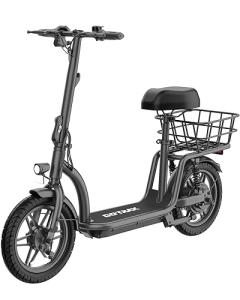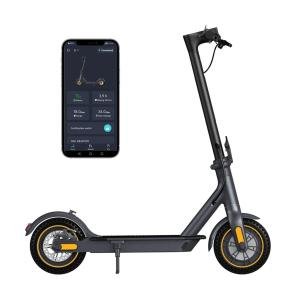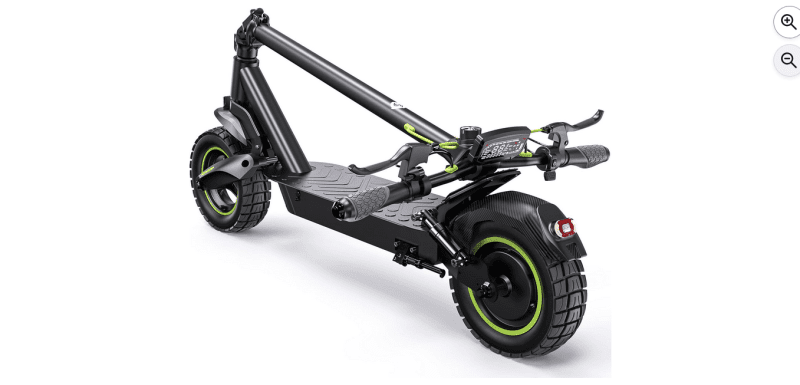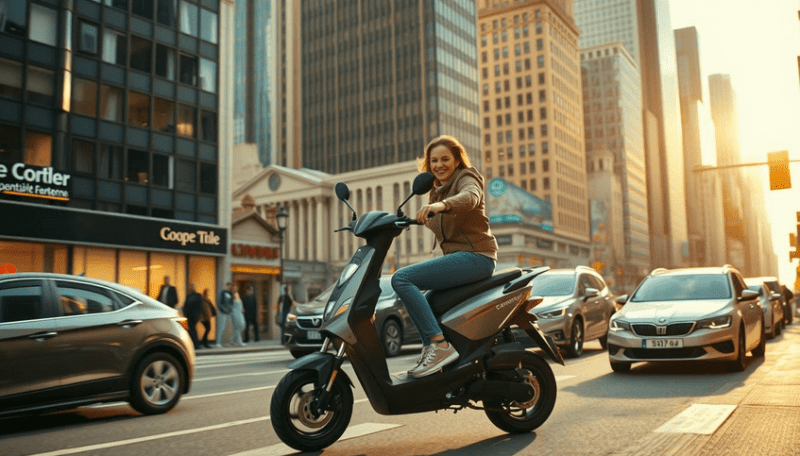Can I Ride an Electric Scooter in Bike Lanes?
Are you wondering if it's permissible to ride an electric scooter in bike lanes? Let's dive into the rules and regulations you need to know.
Key Takeaways:
- Rules regarding electric scooters in bike lanes vary by state.
- In New York State, electric scooters and electric bicycles are permitted on certain streets and highways, provided the speed limit is 30 MPH or less.
- Operating electric scooters on sidewalks is generally not permitted without authorization from local law or ordinance.
- In Texas, there don't appear to be specific laws regarding the use of electric scooters in bike lanes; however, regulations exist for electric bicycles.
- Consult local laws and regulations to determine if riding an electric scooter in bike lanes without pedaling is permitted.
Understanding the Laws in Your State
To determine whether you can ride an electric scooter in bike lanes, it's crucial to familiarize yourself with the laws in your particular state. The rules and regulations surrounding scooter usage can vary significantly, so it's essential to consult local laws and regulations to understand any bike lane restrictions or permissions that may be in place.
In New York State, for example, electric scooters and bicycles with electric assist are allowed on some streets and highways, as long as the speed limit is 30 MPH or less. However, operating these devices on sidewalks is generally not permitted unless authorized by local law or ordinance.
🛴 Electric Scooter Bike Lane Access by State (2025)
Alabama – Conditional: Local rules govern; many cities follow bicycle rules with speed caps.
Alaska – Conditional: Municipality-by-municipality; lighting/helmet often required for minors.
Arizona – Yes: Treated similarly to bikes in many cities; speed limits and lighting apply.
Arkansas – Yes: Generally allowed in bike lanes with local speed/age rules.
California – Yes: Allowed in bike lanes; typical max ~15 mph; no sidewalks; helmet for riders under 18.
Colorado – Yes: Allowed in bike lanes and low-speed roads; local restrictions may apply.
Connecticut – Yes: Often allowed on bike lanes/paths; speed/lighting requirements.
Delaware – Conditional: Local ordinances decide; follow bicycle rules where permitted.
Florida – Yes: Commonly allowed in bike lanes; sidewalk use often restricted.
Georgia – Yes: Allowed in many jurisdictions; local speed/age rules apply.
Hawaii – Yes: Allowed in bike lanes; helmets are usually required for riders under 18; lighting is required at night.
Idaho – Conditional: City rules govern; many treat like bicycles with limits.
Illinois – Yes: Permitted in bike lanes; lighting and basic equipment required.
Indiana – Yes: Typically allowed with local speed caps; treated like bicycles.
Iowa – Conditional: Local ordinances decide; check city code.
Kansas – Conditional: Local control; some cities permit bikes in bike lanes with restrictions.
Kentucky – Yes: Often treated like bicycles; follow local speed/lighting rules.
Louisiana – Yes: Allowed in bike lanes in many areas; equipment/lighting rules apply.
Maine – Conditional: Local rules vary, with many aligning with bicycle use.
Maryland – Yes: Commonly allowed in bike lanes; local restrictions possible.
Massachusetts – Yes: Allowed in bike lanes/paths; license/permit and 20 mph cap often cited.
Michigan – Yes: Allowed in bike lanes/roads ≤25 mph; follow bike rules.
Minnesota – Yes: Allowed; typical cap ~15 mph; lights at night required.
Mississippi – Conditional: Local-rule state; check city ordinances.
Missouri – Yes: Allowed; many cities set ≤30 mph road limit and lighting rules.
Montana – Yes: Allowed with limits; localities may restrict sidewalks/speeds.
Nebraska – Conditional: Unclear/locally governed; some age minimums posted.
Nevada – Yes: Allowed in bike lanes/paths; typical speed limit is ~15 mph; local rules add detail.
New Hampshire – Conditional: Local-rule state; verify city guidance.
New Jersey – Yes: Legalized low-speed e-scooters; bike lane use generally allowed.
New Mexico – Conditional: Local ordinances control; check city code.
New York – Yes: Legal statewide; bike lanes allowed; ~15 mph cap; no sidewalks.
North Carolina – Conditional: Local-rule state; many cities treat like bicycles.
North Dakota – Conditional: Local control; verify municipal code.
Ohio – Yes: Allowed in bike lanes; typical cap ~20 mph; lighting required.
Oklahoma – Yes: Allowed; common speed cap ≤25 mph; local rules may vary.
Oregon – Yes: Allowed in bike lanes/roads ≤25 mph; age ≥16; ~15 mph cap.
Pennsylvania – No / Pilots only: State law prohibits on public roads/sidewalks/bike lanes; Pittsburgh pilot allows bike lanes on roads ≤25 mph; Philadelphia disallows.
Rhode Island – Conditional: Local-rule state; Providence and others set specifics.
South Carolina – Conditional: Local ordinances decide; many align with bicycle use.
South Dakota – Yes: Allowed with a speed limit of ~15 mph; equipment rules apply.
Tennessee – Yes: Allowed with ~15 mph cap; lighting required; local nuance.
Texas – Yes: Commonly allowed in bike lanes; sidewalk restrictions in business districts.
Utah – Yes: Allowed in bike lanes; speed/age rules; lights at night required.
Vermont – Conditional: Local-rule state; verify municipal guidance.
Virginia – Yes: Allowed in bike lanes/paths in many localities; local rules add detail.
Washington – Yes: Allowed in bike lanes; sidewalks often restricted in city cores.
West Virginia – Conditional: Local ordinances govern; check city/county code.
Wisconsin – Yes: Allowed with typical speed caps; lighting and braking required.
Wyoming – Conditional: Local-rule state; verify city code before riding.
Remember, every city and state may have different regulations and guidelines for riding electric scooters in bike lanes. It is essential to research and understand the local laws to ensure compliance and a safe riding experience. By following these suggestions and being considerate of others, you can enjoy the convenience of electric scooters while sharing the road responsiby
Legalities and Etiquette in Bike Lanes
Understanding the legalities and practicing appropriate etiquette is crucial when riding an electric scooter in bike lanes. While the rules and regulations surrounding electric scooter usage in bike lanes can vary by state, it's important to comply with local laws to ensure a safe and harmonious experience for all users.
In New York State, electric scooters and bicycles with electric assistance are permitted on certain streets and highways, provided the speed limit is 30 MPH or less. However, operating these devices on sidewalks is generally not permitted unless authorized by local law or ordinance. This means that if you're riding an electric scooter in New York State, it's important to stay within the designated bike lanes and adhere to any specific guidelines or speed limits that may be in place.
In Texas, there don't appear to be specific laws about riding an electric scooter on bike lanes. However, there are regulations for electric bicycles, which must be designed to be propelled by an electric motor and human power and cannot exceed a speed of 20 miles per hour without the application of human power. This implies that electric scooter riders in Texas should exercise caution and be mindful of their surroundings when sharing the bike lane with cyclists and pedestrians.
Ultimately, it is crucial to consult local laws and regulations to determine if riding an electric scooter in bike lanes without pedaling is permitted. By understanding the legalities and adhering to proper etiquette, we can ensure a safe and enjoyable riding experience for everyone.
| State | Electric Scooter Regulations |
|---|---|
| New York | Allowed on certain streets and highways with a speed limit of 30 MPH or less. Operating on sidewalks is generally not permitted unless authorized by local law or ordinance. |
| Texas | No specific laws for electric scooters, but regulations for electric bicycles exist. Electric bicycles must be designed to be propelled by an electric motor and human power and cannot exceed a speed of 20 miles per hour without the application of human power. |
Researching Local Regulations
Each locality may have its own set of regulations and guidelines for electric scooter use in bike lanes, making it essential to research and stay informed. Whether you're a resident or a visitor, understanding the specific rules and permissions in your area will help ensure a safe and compliant riding experience.
When researching local regulations, start by consulting the city or county authorities responsible for overseeing transportation and mobility. Look for information on their official websites or contact their dedicated departments for guidance on electric scooter lane permissions, scooter lane restrictions, and scooter usage guidelines in bike lanes.
Summary:
Researching local regulations is crucial for anyone looking to ride an electric scooter in bike lanes. Each locality may have its own unique rules, permissions, and restrictions. Checking with city or county authorities, reviewing local ordinances, and staying informed about specific guidelines will help ensure a safe and compliant riding experience.
Safety Considerations for Scooter Riders
Safety should be a top priority for scooter riders when using designated bike lanes. As electric scooters gain popularity as a mode of transportation, it is important to ensure a safe and harmonious coexistence with other users of the bike lanes, such as cyclists and pedestrians.
First and foremost, always wear appropriate protective gear, including a helmet, knee pads, and elbow pads. Electric scooters can reach high speeds, and any unexpected obstacles or collisions can result in injuries. Protecting yourself with the right gear can greatly reduce the risk of accidents and minimize the severity of injuries.
In addition to protective gear, it is crucial to follow traffic rules and regulations. Electric scooters should adhere to the same rules as bicycles when riding in bike lanes. This includes obeying traffic signals, yielding to pedestrians, and using hand signals to indicate turns. By respecting the rules of the road, you contribute to a safer and more predictable environment for everyone.
Lastly, stay vigilant and aware of your surroundings when riding in bike lanes. Always be mindful of other users, such as cyclists and pedestrians, and give them ample space. Avoid sudden maneuvers or excessive speed that may startle or endanger others. By practicing good judgment and courtesy, you can help create a positive experience for all users of the bike lanes.
| Safety Tips for Scooter Riders: |
|---|
| Always wear protective gear, including a helmet, knee pads, and elbow pads. |
| Follow traffic rules and regulations, including obeying traffic signals and yielding to pedestrians. |
| Stay vigilant and aware of your surroundings, respecting the space and safety of others in the bike lane. |
Quote:
Safety is not an accident. It's a choice we make every time we ride an electric scooter in a designated bike lane.
The Future of Electric Scooters in Bike Lanes
As electric scooters gain popularity, ongoing developments in rules and infrastructure are expected to ensure their integration into bike lanes. As more people opt for eco-friendly and convenient modes of transportation, cities and municipalities face the challenge of accommodating the growing number of electric scooters on their roadways. This has led to discussions and initiatives aimed at establishing clearer guidelines and regulations for riding electric scooters in bike lanes.
One potential development is the implementation of designated lanes or shared spaces specifically designed for electric scooters and bicycles. These lanes would provide a dedicated area for riders, separating them from pedestrians and cars, and promoting safer and more.
In conclusion, as electric scooters continue to grow in popularity, it is expected that regulations and infrastructure will evolve to accommodate their presence in bike lanes. With ongoing developments in rules, infrastructure, and safety measures, riding electric scooters in bike lanes could become a more seamless and integrated part of urban transportation systems. As we move forward, riders and cities alike must work together to create a harmonious and safe environment for all road users.
Considering Local Factors
Understanding the local factors and respecting the unique rules and regulations of each area is crucial when riding electric scooters in bike lanes. While there may not be specific laws governing the use of electric scooters in bike lanes in some states, it is essential to note that regulations often exist for electric bicycles. These regulations typically include speed restrictions and requirements for the motor to be designed for human power assistance.
For example, in Texas, there don't appear to be specific laws regarding the use of electric scooters in bike lanes. However, there are regulations for electric bicycles, which must be designed to be propelled by an electric motor and human power and cannot exceed a speed of 20 miles per hour without the application of human power. It is always advisable to adhere to the speed limits and guidelines set for these vehicles to ensure safety and compliance with local regulations.
Given the varying rules and regulations in different states, it is essential to consult local laws and regulations to determine if riding an electric scooter on bike lanes without pedaling is permitted. While some states may not have specific laws governing electric scooters, it is always best to err on the side of caution and follow the rules and guidelines in place for electric bicycles or other relevant vehicles. This will help create a harmonious environment for all users of bike lanes and ensure the safety of both scooter riders and cyclists.
Conclusion
Riding an electric scooter in bike lanes can be a convenient and efficient mode of transport. Still, it's essential to stay informed, follow the rules, and prioritize safety to ensure a positive experience for all.
According to the information sources, the rules regarding riding an electric scooter on bike lanes vary by state. In New York State, electric scooters and bicycles with electric assistance are permitted on certain streets and highways, provided the speed limit is 30 MPH or less. However, operating these devices on sidewalks is generally not permitted unless authorized by local law or ordinance.
In Texas, there don't appear to be specific laws about riding an electric scooter on bike lanes. Still, there are regulations for electric bicycles, which must be designed to be propelled by an electric motor and human power and cannot exceed a speed of 20 miles per hour without the application of human power. Therefore, it is important to consult local laws and regulations to determine if riding an electric scooter on bike lanes without pedaling is permitted.
By staying informed about the specific regulations in your area, you can enjoy the benefits of riding an electric scooter in bike lanes while also respecting the safety and rights of other road users. Remember to wear appropriate protective gear, follow traffic rules, and maintain vigilance while sharing the road with cyclists, pedestrians, and motorists. Together, we can create a harmonious and enjoyable environment for all.
FAQ
Can I ride an electric scooter in bike lanes?
The rules regarding riding an electric scooter in bike lanes vary by state. It is important to consult local laws and regulations to determine if riding an electric scooter in bike lanes is permitted.
What are the regulations for riding an electric scooter in New York State?
In New York State, electric scooters and bicycles with electric assist are allowed on some streets and highways, as long as the speed limit is 30 MPH or less. However, operating these devices on sidewalks is generally not permitted unless authorized by local law or ordinance.
Are there specific laws governing the use of electric scooters in bike lanes in Texas?
While there don't appear to be specific laws about riding an electric scooter on bike lanes in Texas, there are regulations for electric bicycles. Electric bicycles must be designed to be propelled by both an electric motor and human power, and they cannot exceed a speed of 20 miles per hour without the application of human power.
What should I consider when riding an electric scooter in bike lanes?
When riding an electric scooter in bike lanes, it is important to consider sharing the space with cyclists, follow traffic rules, wear protective gear, and stay vigilant to ensure a safe experience for all users.
What legalities and etiquette should I be aware of when riding an electric scooter in bike lanes?
The legalities of riding an electric scooter in bike lanes can vary, so it is important to adhere to local laws and regulations. Additionally, proper etiquette, such as respecting other users and following lane-sharing protocols, is crucial for a harmonious and safe riding experience.
How can I research the local regulations for electric scooters in bike lanes?
To understand specific permissions or restrictions for riding electric scooters in bike lanes, it is advisable to research local laws and regulations by contacting city or county authorities.
What safety considerations should I keep in mind when riding an electric scooter in bike lanes?
Safety is paramount when riding an electric scooter in bike lanes. It is important to wear appropriate protective gear, follow traffic rules, and be aware of your surroundings to ensure the safety of yourself and others using the road.
What does the future hold for electric scooters in bike lanes?
The future of electric scooters in bike lanes may involve advancements in regulations, technology, and infrastructure to accommodate the increasing popularity of electric scooters as a mode of transportation.
What local factors should I consider regarding riding electric scooters in bike lanes?
It is crucial to consider local factors, such as individual city or regional rules and attitudes toward electric scooters, to ensure compliance with local regulations and a smooth riding experience.
Caution:
"Ensure Your Safety! Do not leave your scooter or e-bike batteries unattended while charging. Overheating may occur, leading to potential fire hazards. Always monitor the charging process and disconnect once fully charged to prevent any safety risks. Your vigilance is crucial in maintaining a secure charging environment and protecting both yourself and your electric vehicle from potential dangers."
DISCLAIMER
This document is provided for general information purposes only and should not be relied upon as providing legal advice, technical, or specific operational guidance to the reader, whether as to the practices described in the document or the applicable legal requirements and regulations. Just electricscooters.com expressly disclaims any responsibility for liability arising from or related to the use or misuse of any information in this document.








